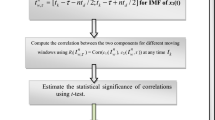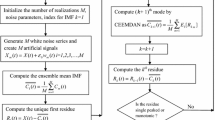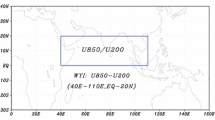Abstract
This study proposes an efficient framework employing Ensemble Empirical Mode Decomposition (EEMD) algorithm coupled with Time-Dependent Intrinsic Cross Correlation (TDICC) method to detect the teleconnection between large scale climatic oscillations and monthly rainfall of India. Indian Ocean Dipole (IOD), El Niño Southern Oscillation (ENSO) and the enhanced convective phases of Madden Julian Oscillation (MJO) have taken into consideration as climatic oscillations for the teleconnection study. EEMD method decomposed each signal to a set of zero mean oscillatory modes namely Intrinsic Mode Functions (IMFs)with definite periodicity. The time-dependent running correlation analysis of the IMFs of ENSO and IOD showed strong negative correlation with the modes of rainfall, at inter annual scales. All the IMFs of MJO indices 8–10 showed very strong positive correlation while MJO indices 2 and 3 showed very strong negative correlations with the corresponding IMFs of rainfall. TDICC analysis found the most influential antecedent information of climatic oscillation in the prediction of IMFs of rainfall at different time scales. On considering the different lags in TDICC analysis, the high frequency modes are associated with transition in correlation from positive to negative and vice versa while low frequency modes display a stable pattern in the teleconnections of rainfall with climatic oscillations. The TDIC-based identification of relevant modes and TDICC-based identification of significant lags will substantially alleviate the computational complexities and help in improved predictions of monthly rainfall over India.









Similar content being viewed by others
Availability of data and material
The datasets analysed during the current study are publicly available in the website of Indian Institute of Tropical Meteorology (IITM) (http://www.tropmet.res.in). Climate Prediction Center (CPC), NOAA data sets (https://www.cpc.ncep.noaa.gov. and https://www.esrl.noaa.gov).
Code availability
The code generated during the current study are available from the corresponding author on reasonable request.
References
Abraham A, Steinberg D, Philip NS (2001) Rainfall forecasting using soft computing models and multivariate adaptive regression splines. IEEE SMC Trans Spec Issue Fusion Soft Comput Hard Comput Ind Appl 1:1–6
Adarsh S, Janga Reddy M (2016) Analysing the hydroclimatic teleconnections of summer monsoon rainfall in Kerala, India using Multivariate Empirical Mode Decomposition and time dependent intrinsic Correlation. IEEE Geosci Remote Sens Lett 13(9):1221–1225
Adarsh S, Janga Reddy M (2017) Multiscale characterization and prediction of monsoon rainfall in India using Hilbert-Huang transform and time-dependent intrinsic correlation analysis. Meteorol Atmos Phys 130:667–668
Adarsh S, Janga Reddy M (2019) Multiscale characterization and prediction of reservoir inflows using MEMD-SLR Coupled Approach. J Hydrol Engng ASCE. https://doi.org/10.1061/(ASCE)HE.1943-5584.0001732
Antico A, Schlotthauer G, Torres ME (2014) Analysis of hydroclimatic variability and trends using a novel empirical mode decomposition: application to the Paraná River Basin. J Geophys Res Atmos 119:1218–1233
Araghi A, Mousavi Baygi M, Adamowski J, Martinez C (2017) Association between three prominent climatic teleconnections and precipitation in Iran using wavelet coherence. Int J Climatol 37:2809–2830
Ashok K, GuanZ YT (2001) Impact of the Indian Ocean dipole on the relationship between the Indian monsoon rainfall and ENSO. Geophys Res 28:4499–4502
Ashok K, Saji NH (2007) On the impacts of ENSO and Indian Ocean dipole events on sub-regional Indian summer monsoon rainfall. Nat Hazards 42:273–285
Azad S, Rajeevan M (2016) Possible shift in the ENSO–Indian monsoon rainfall relationship under future global warming. Sci Rep 6:20145. https://doi.org/10.1038/srep20145
Bala I, Singh OP (2008) Relationship between Indian Ocean dipole and summer monsoon. Mausam 59:167–172
Bhalme HN, Jadhav SK (1984) The double (Hale) sunspot cycle and floods and droughts in India. Weather 39:112
Bhattacharya S, Narasimha R (2007) Regional differentiation in multi-decadal connections between Indian monsoon rainfall and solar activity. J Geophys Res 112:D24103
Bond NA, Vecchi GA (2003) The influence of the madden–Julian oscillation on precipitation in oregon and Washington. Weather Forecast 18(4):600–613
Campbell WH, Blechman JB, Bryson RA (1983) Long period tidal forcing of Indian monsoon rainfall: a hypothesis. J Clim Appl Meteorol 22:287–296
Chen X, Wu Z, Huang NE (2010) The time-dependent intrinsic correlation based on the empirical mode decomposition. Adv Adapt Data Anal 2:233–265
Chowdary J, Parekh A, Gnanaseelan C (2021) Indiansummer monsoon variability teleconnections and beyond. Elsevier. https://doi.org/10.1016/C2019-0-04482-2
Claud C, Pascal T (2007) Revisiting the possible links between the quasi-biennial oscillation and the Indian summer monsoon using NCEP R-2 and CMAP fields. J Clim 20:773–787
Dasgupta P, Metya A, Naidu CV et al (2020) Exploring the long-term changes in the Madden Julian Oscillation using machine learning. Sci Rep 10:18567. https://doi.org/10.1038/s41598-020-75508-5
Ebisuzaki W (1997) A method to estimate the statistical significance of a correlation when the data are serially correlated. J Climate 10(9):2147–2215
Fahimi F, Yaseen ZM, El-shafie A (2017) Application of soft computing based hybrid models in hydrological variables modeling: a comprehensive review. Theor Appl Climatol 128:875–903
Gadgil S, Asha G (1992) Intraseasonal variation of the summer monsoon. I: observational aspects. J Meteor Soc Japan 70:517–527
Gadgil S, Vinayachandran PN, Francis PA, Gadgil S (2004) Extremes of the Indian summer monsoon rainfall, ENSO and equatorial Indian Ocean oscillation. Geophys Res Lett 31:L12213. https://doi.org/10.1029/2004GL019733
Gaughan AE, Staub CG, Hoell A, Weaver A, Waylen PR (2016) Inter and Intra annual precipitation variability and associated relationships to ENSO and the IOD in southern Africa. Int J Climatol 36:1643–1656
Ghosh S, Bhatla R, Mall RK, Srivastava PK, Sahai AK (2018) Aspect of ECMWF downscaled regional climate modeling in simulating Indian summer monsoon rainfall and dependencies on lateral boundary conditions. Theor Appl Climatol 135:1559–1581
Goswami BN, MadhusoodananMS NCP, Sengupta D (2006) Aphysical mechanism for North Atlantic SST influence on the Indian summer monsoon. Geophys Res Lett 33:L02706. https://doi.org/10.1029/2005GL024803
Huang Y, Schmitt FG (2014) Time dependent intrinsic correlation analysis of temperature and dissolved oxygen time series using empirical mode decomposition. J Mar Syst 130:90–100
Huang NE, Shen Z, Long SR, Wu MC, Shih HH, Zheng Q, Yen NC, Tung CC, Liu HH (1998) The empirical mode decomposition and the Hilbert spectrum for nonlinear and non-stationary time series analysis. Proc R Soc Lond Ser A454:903–995
Huang NE, Wu Z, Long SR, Arnold KC, Chen X, Blank K (2009) On instantaneous frequency. Adv Adapt Data Anal 01(02):177–229
Ismail DKB, Lazure P, Puillat I (2015) Advanced spectral analysis and cross correlation based on empirical mode decomposition: application to the environmental time series”. Geosci Remote Sens Lett 12(9):1968–1972
Iyengar RN, Raghu Kanth TSG (2005) Intrinsic mode functions and a strategy for forecasting Indian monsoon rainfall. Meteorol Atmos Phys 90:17–36
Johny K, Pai ML, Adarsh S (2018) Empirical forecasting and Indian Ocean dipole teleconnections of south–west monsoon rainfall in Kerala. Meteorol Atmos Phys 131(4):1055–1065
Johny K, Pai ML, Adarsh S (2020) An investigation on drought teleconnection with Indian ocean dipole and El-Nino southern oscillation for peninsular India using time dependent intrinsic correlation. IOP Conf Ser 491(1):012007
Joseph S, Sahai AK, Goswami BN (2009) Eastward propagating MJO during boreal summer and Indian monsoon droughts. Clim Dyn 32:1139–1153
Kashid S, Maity R (2012) Prediction of monthly rainfall on homogeneous monsoon regions of India based on large scale circulation patterns using genetic programming. J Hydrol 454–455:26–41
Klotzbach P, Abhik S, Hendon HH et al (2019) On the emerging relationship between the stratospheric Quasi-Biennial oscillation and the Madden–Julian oscillation. Sci Rep 9:2981. https://doi.org/10.1038/s41598-019-40034-6
Kothawale DR, Rajeevan M (2017) Monthly, seasonal and annual rainfall time series for all-India, homogeneous regions and meteorological subdivisions: 1871–2016 Research report No. RR-138. Indian Institute of Tropical Meteorology (IITM), Pune
Kripalani RH, Kulkarni A (1997) Climatic impacts of El Niño/La Nina on the Indian monsoon: a new perspective. Weather 52:39–46
Kripalani RH, Kulkarni A, Sabade SS (2001) El Niño Southern Oscillation, Eurasian snow cover and the Indian monsoon rainfall. Proc INSA Part A 67(3):361–368
Krishna Kumar KB, Rajagopalan B, Cane MA (1999) On the weakening relationship between the Indian monsoon and ENSO. Science 284:2156–2159
Kumar KK, Rajagopalan B, Hoerling BM, Bates G, Cane MA (2006) Unraveling the mystery of Indian monsoon failure during El Niño. Science 314:115–119
Lau KM, Chan PH (1980) Aspects of the 40–50 day oscillation during the northern summer as inferred from outgoing longwave radiation. MonWea Rev 114:1354–1367
Lawrence DM, Webster PJ (2002) The boreal summer intraseasonal oscillation: relationship between northward and eastward movement of convection. J Atmos Sci 59:1593–1606
Li Z, Li Y, Bonsal B, Manson AH, Scaff L (2018) Combined impacts of ENSO and MJO on the 2015 growing season drought on the Canadian Prairies. Hydrol Earth Syst Sci 22:5057–5067
Madden RA, Julian PR (1971) Detection of a 40–50 day oscillation in the zonal wind in the tropical Pacific. J Atmos Sci 28:702–708
Maheswaran R, Khosa R (2012) Comparative study of different wavelets for hydrologic forecasting. Comp Geosci 46:284–295
Maity R, Nagesh Kumar D (2008) Basin-scale stream-flow forecasting using the information of large-scale atmospheric circulation phenomena. Hydrol Process 22:643–650
Maity R, NageshKumar D (2006a) Hydro-climatic association of monthly summer monsoon rainfall over India with large-scale atmospheric circulation from tropical Pacific Ocean and Indian Ocean. AtmosSci Lett 7(4):101–107
Maity R, NageshKumar D (2006b) Bayesian dynamic modeling for monthly Indian summer monsoon rainfall using El Niño-Southern Oscillation (ENSO) and Equatorial Indian Ocean Oscillation (EQUINOO). J Geophys Res 111:D07104
Maity R, Kumar DN, Nanjundiah RS (2007) Review of hydroclimatic teleconnection between hydrologic variables and large-scale atmospheric circulation patterns with Indian perspective. ISH J Hydraul Eng 13:77–92
Massei N, Fournier M (2012) Assessing the expression of large-scale climatic fluctuations in the hydrological variability of daily Seine river flow (France) between 1950 and 2008 using Hilbert-Huang Transform. J Hydrol 448–449:119–128
Mooley DA, Parthasarathy B (1983) Indian summer monsoon and El Niño. Pageoph 121:339–352
Narasimha R, Bhattacharyya S (2010) A wavelet cross-spectral analysis of solar–ENSO–rainfall connections in the Indian monsoons. Appl Comput Harmon A 28:285–295
Pai DS, Bhate J, Sreejith OP, Hatwar HR (2011) Impact of MJO on the intraseasonal variation of summer monsoon rainfall over India. ClimDyn 36(1–2):41–55
Pant GB, Parthasarathy B (1981) Some aspects of an association between the southern oscillation and Indian summer monsoon. Arch Meteorol Geophys Biokl 29:245–251
Parthasarathy B, Munot AA, Kothawale DR (1994) All-India monthly and seasonal rainfall series: 1871–1993. Theor Appl Climatol 49:217–224
Rajeevan M, Pai DS (2007) On the El Niño-Indian monsoon predictive relationships. Geophys Res Lett 34:L04704. https://doi.org/10.1029/2006GL028916
Sah S, Singh RN, Chaturvedi G, Das B (2021) Trends, variability, and teleconnections of long-term rainfall in the Terai region of India. Theoret Appl Climatol 143(1):291–307
Sahai A, Soman M, Satyan V (2000) All India summer monsoon rainfall prediction using an artificial neural network. Clim Dyn 16:291–302
Saji NH, Goswami BN, Vinayachandran YT (1999) A dipole mode in the tropical Indian Ocean. Nature 401:360–363
Santos GCA, Silva GBLD (2014) Daily streamflow forecasting using a wavelet transform and artificial neural network hybrid models. Hydrol Sci J 59:312–324
Seetharam K (2008) Impact of Madden–Julian oscillations on the Indian summer monsoon sub-divisional rainfalls. Mausam 59(2):195
Singh P, Borah B (2012) Indian summer monsoon rainfall prediction using neural network. Stoch Environ Res Risk Assess 27(7):1585–1599
Singh RN, Sah S, Das B, Potekar S, Chaudhary A, Pathak H (2021) Innovative trend analysis of spatio-temporal variations of rainfall in India during 1901–2019. Theor Appl Climatol 145(1):821–838
Soria AC (2021) MJO teleconnection patterns and their effect on extratropical cyclone activity in the mid-latitudes. Master of science thesis submitted to University Of Wisconsin–Madison USA
Sreedevi V, Adarsh S, Nourani V (2022) Multiscale coherence analysis of reference evapotranspiration of north western iran using wavelet transform. J Wat Clim Change 13(2):505–521
Vinayachandran PN, Francis PA, Rao SA (2009) Indian Ocean dipole: processes and impacts. Curr Trends Sci 46(10): 569 89. https://www.ias.ac.in/public/Resources/Other_Publications/Overview/Current_Trends/569-589.pdf.
Walker GT (1923) Correlation in seasonal variations of weather. VIII. A preliminary study of world-weather. Memoirs Indian Meteorol Dept 24:75–131
Wu Z, Huang NE (2009) Ensemble Empirical Mode Decomposition: A Noise-Assisted Data Analysis Method. Advances in Adaptive Data Analysis 1(1):1-41
Yasunari T (1980) A quasi-stationary appearance of 30–40 day period in cloudiness fluctuations during the summer monsoon over India. J Meteor Soc Jpn 58:225–229
Zhang C (2005) Madden-Julian oscillation. Rev Geophys. https://doi.org/10.1029/2004RG000158
Acknowledgements
The authors are grateful to the Indian Institute of Tropical Meteorology Pune for providing the relevant data regarding rainfall in the public domain. The authors also thank National Oceanic and Atmospheric Administration for making available data regarding ENSO, MJO and IOD indexes for research. The authors also thank Department of Computer Science and IT, Amrita School of Arts and Sciences for the support provided.
Funding
No funding was received for conducting this study.
Author information
Authors and Affiliations
Corresponding author
Ethics declarations
Conflict of interest
The authors have no conflicts of interest to declare that are relevant to the content of this article.
Additional information
Responsible Editor: Emilia Kyung Jin.
Publisher's Note
Springer Nature remains neutral with regard to jurisdictional claims in published maps and institutional affiliations.
Supplementary Information
Below is the link to the electronic supplementary material.
Rights and permissions
About this article
Cite this article
Johny, K., Pai, M.L. & Adarsh, S. Time-dependent intrinsic cross-correlation approach for multi-scale teleconnection analysis for monthly rainfall of India. Meteorol Atmos Phys 134, 73 (2022). https://doi.org/10.1007/s00703-022-00910-9
Received:
Accepted:
Published:
DOI: https://doi.org/10.1007/s00703-022-00910-9




